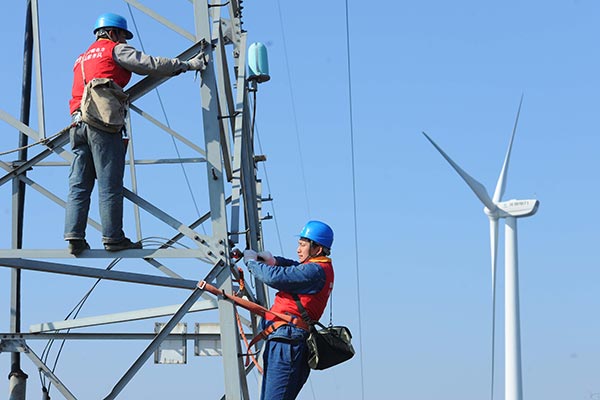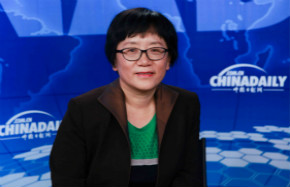Better planning can boost new energy sector
 |
|
Workers with the power supply company in Chuzhou, Anhui province, check the transmission network under the State Grid before it is connected with a local wind power farm. SONG WEIXING / FOR CHINA DAILY |
China has made notable progress in the use of renewable energy. By the end of last year, China had installed 149 gigawatts of wind-power and 77 gigawatts of photovoltaic power. The corresponding figures for 2011 were just 46 gigawatts and 2 gigawatts.
In comparison, Germany, a leading producer of renewable energy, appears to lag behind both in the number of installations and total power production.
The wind-power installations connected to regular power grids in China accounted for about 4 percent of last year's total electricity output, nearly 1.1 percent of which was from the photovoltaic power plants.
The curtailment rate of wind and solar installations, mostly in Northwest China, remains a major hindrance for better use of clean energy. The curtailment rate of wind and photovoltaic power installations reached 14.6 percent in 2015 and increased to nearly 20 percent last year. The annual average hours of generating electricity via wind- and solar-power plant capacities, too, registered a steady decline from 2011 to 2016.
Because of curtailment rate of wind and solar, a huge amount of energy resources was wasted. The estimated 70 billion kilowatt-hours of electricity wasted during last year is equal to the basic power consumption of about 29 million households for one whole year and half of Shanghai's annual consumption.
But the curtailment rate could be even higher considering that the solar- and wind-power plants can theoretically generate much more electricity. It is likely that only 60 percent of the total wind and solar power generation potential has been actually put to use.
The root cause of China's energy exploitation dilemma is the imbalanced production-consumption relationship. The renewable resource-rich northwestern region, including Gansu province and the Xinjiang Uygur autonomous region, have limited demand for renewable energy, which accounted for more than 15 percent of their total power output in 2015, because it cannot export all the extra power generated to other regions for lack of supply channels and higher transmission costs.
But overstating China's problems in comparison to Germany's successful exploitation of renewable energy is uncalled for. Germany's power grids largely depend on distributed generation, which refers to renewable energy systems of less than 20 megawatts like rooftop solar photovoltaic arrays. And a more flexible price mechanism has made it easier for the country to promote solar and wind installations, which, however, comes at higher costs for consumers.
Being a trailblazer in renewable energy development, China, on the other hand, needs time and effort to solve its problems because no country has ever generated and distributed as much "clean" electricity as it is doing today. China also has to optimize the energy structure as well as balance the unstable demand. The notable curtailment rate of wind- and solar-power installations is a key indicator of current oversupply of electricity, which can be as unavoidable as power shortage in a country undergoing fast growth.
To solve the problem, the authorities concerned have to work out long-term plans that encourage clean energy generation and endorse the building of cross-region electricity grids, and provinces in East and Central China that have strong demand for electricity should install more photovoltaic power plants. And to clear the bottlenecks in the long run, extra efforts are called for to expand distributed generation.
The author is dean of China Institute for Studies in Energy Policy at Xiamen University.
- China's State Grid inks deal for purchase of stake in Greek power grid operator
- PPC says China's State Grid offers highest bid for stake in Greek power grid operator
- New wind power projects banned in six regions due to wastage
- China's wind power capacity continues to grow
- Solar power has sunny prospects
- Solar power project under construction above fishery water

























